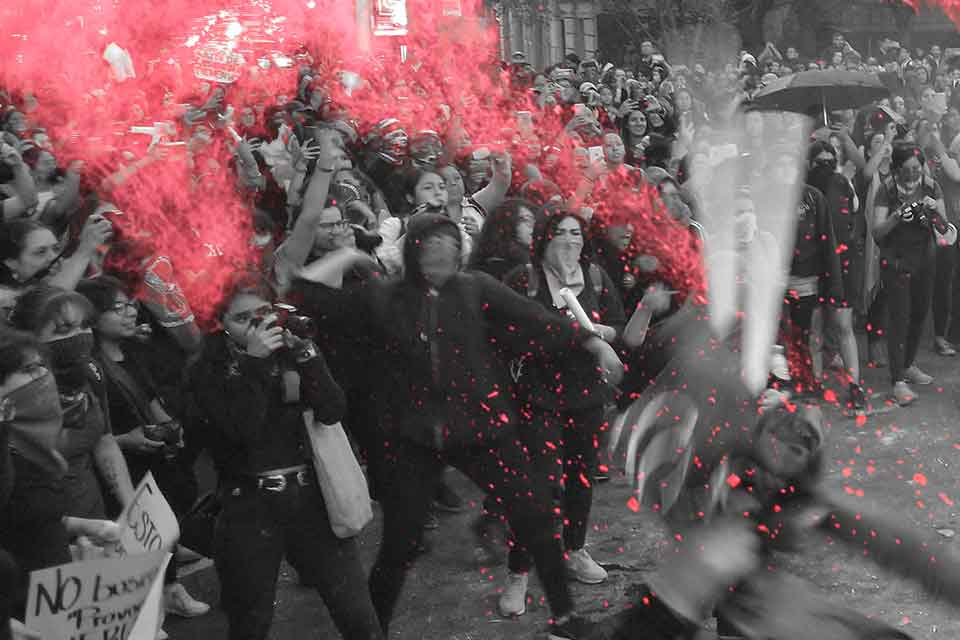We Will Not Let Each Other Go

In Mexico’s “glitter revolution,” women stand in solidarity, protesting escalating violence against women. “This march belongs to us,” writes the author, “nosotras in the feminine, and plural.”
1.
One, two. I count the women I pass on Avenida Insurgentes as I walk to the roundabout. I also pay attention to the men, but that count is different, more rushed. There are lots of them, and to keep up, I have to skip over some numbers, counting in twos or threes. One–three–six–eight. Since I turned off Milán Street to here, I’ve seen so many (it’s impossible to keep the mental count) men who are alone; the women, on the other hand, are in pairs or in groups. Grandmother, mother, daughter. Two friends. Very few walk alone: three, if I include myself.
I know that when I arrive at the roundabout it’ll be different: there will be women, women smiling everywhere, an incredible and immense majority of women, and among them I’ll feel completely safe . . . but for now, I need to cover a few more streets. I decide to share my real-time location in the group chat I have with a few of my amigas, until I arrive. It’s only a kilometer, aren’t you overreacting? Sometimes I’m embarrassed by the ridiculous things I do because of fear. Why did you run? Can’t you see? he didn’t do anything to you. You’re thirty-three years old, you’re not a little girl, stop being so scared all the time. But now I have my rebuttal at hand: I think of the other women, those who died a few blocks from or even just outside—at the door of—their houses. I start to do math, calculating probabilities, the probability of my death. They assassinate women between the ages of twenty and thirty-five (36 percent of cases). Single, the majority. They kill women who went to college (24.7 percent of those who were between twenty-eight and thirty-five years old at their deaths). The numbers get worse in the surrounding state of México, where they strangle more (26.7 percent) and kill more (the number murdered, for every hundred thousand women, was 5.3 in 2017).1 This country offers no evidence to the contrary; in Mexico phobias do not exist, because here, fear is never irrational.
I should let my amigas know where I am, in the chat. If I need them, they’ll come; if I disappear, they’ll know where I was when it happened. The conviction I have in them (today while I wait for the streetlight to turn red, the last time that I went out at night, every day since we started this group on Whatsapp) dissolves my nerves. Crossing the street, I see a woman dressed completely in black, which the call to protest suggested. She’s a feminist like me, I think, if something happens to me she’ll be the first to help me, and me her. I follow her to the roundabout, no longer paying attention to the men with whom we share the asphalt, medians, and sidewalks. Together we cross under a bridge—something I’d never do alone; I trust her without even knowing her—and from one moment to the next they appear.
Women, all women. Is it a hundred? Two hundred? They spill past my field of vision. They are, finally, as uncountable as the men were a few seconds ago. And even though I don’t know any of them, my body feels no anxiety or fear. (The next day I’d realize that I felt so safe in that moment that I forgot to share my location in the chat.) I walk without worry, with confidence. I could be in just my underwear, in a towel, even naked—and ab-so-lute-ly no-thing would happen to me.
Women, all women. And even though I don’t know any of them, my body feels no anxiety or fear.
I walk along among the women dressed in black who brim over in number and happiness, in conviction and well-founded rage. I find Jimena, Montserrat. I didn’t come with them to the march but that doesn’t matter: they paint my cheeks with violet glitter, they show me how to knot the green bandana around my neck. “I have purple lipstick,” I tell them as I take it out of my bag, and they pass it from woman to woman. We share not only our fear and anger but also the colors and goals of the cause. “I’m here,” Alejandra says in the chat. I tell her where exactly I am in the roundabout, not worrying how she’ll get here because she’s also among all of us, nosotras. The complicated concept of sorority is sure and tangible here: if she needs something, as trivial or serious as it might be, the women around her—whom she also doesn’t know—would help right away. Here is the exception. Here we are creating another place, one so infrequent and unrecognizable that at times it doesn’t seem like real life but like a feminist science-fiction story.
2.
While the television cameras aim at what the reporters describe as “riots, chaos, vi-o-len-ce!” I step onto the platform of the Metrobús. With my little notebook and a simple pen in hand, I manage to speak to the women who light a small fire, which never gets out of control and lasts for very little time, though dozens of photographers wait for it to rekindle so they can capture the scene.
“You’re here to take pictures of us, to take our names, right?” asks a woman with her nose and mouth covered by a scarf.
“No, no names, anonymous,” I respond. “I just want to know what you’re thinking.” She looks me over quickly, as though examining my all-black outfit, my pro-abortion bandana, the purple glitter, and my complete lack of intent to record her name or give her away. And she decides to trust me, even though she doesn’t know me.
“Write this: not a single Mexican media source is telling the truth. The media are criminalizing us. They’re going to say that we’re men, that we’ve been planted. No. We’re angry women.”
The next morning, the headlines and front pages of various national newspapers confirm her expectations. Fire. Riots. Chaos. Violence. All in capital letters. I look over the papers and remember her, trying to break the cameras in the Metrobús station. Now, I know that the press is friendly only to some feminists. As I continue devouring the information in the newspapers, I read that the mayor, the jefa de gobierno, announced that she will open investigations against the women I interviewed, those who would never attend the roundtable discussion that was transmitted via Periscope that Thursday, not even as a joke. But it’s also true that Mayor Claudia Sheinbaum didn’t invite them to that initial dialogue: the first thing she did was surround herself with various established NGOs, institutional ones made up of academics and respected activists. The state likes shortcuts, the feminist Sonia E. Alvarez explained in the 1990s, and connecting with NGOs allows it to adopt a democratic face, even though proper civic participation requires much more than listening to the advice, evaluations, and reports of specialists.2 On top of this, it’s a strange, even self-serving relationship the Morena political party has with these organizations. When the issue was childcare and shelter for—precisely—women who were victims of domestic violence, President López Obrador scorned the NGOs; now, when the issue is sexual violence against women as committed by the police, the government’s sudden intimacy with NGOs feels (at least) opportunist.
News: two days later, after a meeting with forty young feminists, the mayor would reconsider: “Sheinbaum takes a step back,” “there will be no investigation.” Could it be that their protest showed Claudia that there are various groups within feminism? Will she, in the future, consult with the women marching on the streets, the feminists who self-finance their activism and aren’t part of an NGO? For feminism to be democratic, we need both: the gender-studies specialists and those who are not.
3.
Three women, standing on a pedestal, begin to read appeals from a sheet of paper. The speaker at their feet scatters their complaints through the Insurgentes roundabout. They condemn the leaks that gave away the identity of a teen girl who accused police in Azcapotzalco of sexual assault (we’ve been asking for the same things for decades), the always “misplaced” evidence (again, decades), the kinds of information and public statements that the authorities offer (how many times do we need to repeat ourselves?). The rage didn’t start with this government, but this party, the progressive left—if you can still call it that—came to power after Miguel Mancera and Enrique Peña Nieto, after Felipe Calderón. The feminists have an accumulated ire, an uncontainable frustration, that goes well beyond the system of six-year presidencies and political parties. This is what Sheinbaum and López Obrador are facing. To understand the women of my generation, you have to know that we grew up hearing the news of the ongoing femicides in Juárez—they started in 1993, when I was seven years old. We grew up hearing that women are killed. Our anger couldn’t do anything but grow, though today, Monday, the president says that “there are cases like these [the feminist march], but, in general [. . .] the people are happy, happy, happy [. . .]. The social mood is not bad.” Is he demanding that we put on a smile?
To understand the women of my generation, you have to know that we grew up hearing the news of the ongoing femicides in Juárez.
At the protest, in the roundabout, there are sounds of astonishment. Five or six women are bent over the ground, not to clean or sweep it “as they should,” but to fill it with spray-painted letters: We won’t forget, we won’t forgive, radfem, policía = violicía. One of them presses the valve and lights the aerosol, and nobody is afraid of this fire that is smaller and shorter-lived than the bursts of flame that the city’s torch-twirling street performers spit into the air at traffic intersections. No woman, no reporter is hurt. It’s like the fire people dance with on the beach, I think, like at raves.
“The government itself and its armed forces commit the crimes, protect the aggressors, and silence the victims,” say the three young women who are still reading the sheet of complaints. It brings us “the same terror as organized crime.” I agree with them. In the state of Guerrero, before President Calderón decided to start his war on drugs, the number of women killed per one hundred thousand was 4.7. Two years later, it doubled (to 9.1 in 2009), and it reached 13.3 in 2016 with Peña Nieto as president. In the north, the state of Chihuahua’s number in 2007 was 3 murdered women per hundred thousand, which increased to 11.1 in the next year and tripled, in 2010, to 33.5! In just two years, between 2015 and 2017, the state of Colima went from 7.2 to 19.2.3 I’m not the first to say it: the presence of armed forces in this country raises the number of deaths, male and female. The federal government knows it, the local government too, and yet the National Guard still operates in eight of the regional alcaldías of Mexico City, including, for example, Xochimilco, where two years ago the Observatorio Ciudadano Nacional del Feminicidio (OCNF; National Citizens’ Observatory on Feminicide) found a pattern of violence connecting organized crime, the brutal deaths of women, and the use of public spaces.4 Other such patterns, the director of the OCNF Luz María Estrada said, have been found in the alcaldías of Tlalpan and Gustavo A. Madero: “[The authorities] must examine what is happening in these areas.”
They know that the femicides, the rapes and sexual assaults, the kidnapping and torturing of women skyrockets when troops and military officers occupy a space.
As I write this, I think that the feminists from Friday’s march have it right, but the capital’s government (in its public announcements) and the media (in its publications) haven’t taken up the matter. “The military justice code needs reforming!” “No jurisdiction!” urged the women who continued reading, from one of the pedestals in the roundabout, their demands. They know that the femicides, the rapes and sexual assaults, the kidnapping and torturing of women skyrockets when troops and military officers occupy a space.
No woman trusts the National Guard.
4.
And almost no women brought a man to the protest. No husbands, no boyfriends, no fuckboys, no friends, co-workers, fathers, bosses. Nobody talks about them. A few appear, without being called to come by anyone, at different points on the route. Edith, who wears a pastel pink raincoat to look, in her words, as though she wouldn't hurt a fly, takes a broom made of palm from one of the medians and “sweeps” the gate-crashers away. Chantal follows along. (I think of the feminist marches of the 1980s, when women and artists went out with brooms, aprons, and recipes “to give the evil eye to rapists”—as Mónica Mayer and Maris Bustamante did—redefining these objects from the domestic sphere with a political intention in the public sphere.)
Edith, who wears a pastel pink raincoat to look, in her words, as though she wouldn't hurt a fly, takes a broom made of palm from one of the medians and “sweeps” the gate-crashers away.
“Right on, compañera!” a woman celebrates Edith, who continues sweeping the men that insist upon entering the crowd against the wishes—reiterated to exhaustion—of the protesters. Finally they leave, or they distance themselves, and that feels like a victory. They don’t want men to defend them, and they especially don’t want men to talk to them and correct or instruct them on “the respectable way to protest,” when they’re conservatives, or on “the real way to fight,” when they’re leftists or human rights activists. They don’t want them there, not even as support. “It’s not your fight,” you can hear every time they kick men out of the contingent. Many accuse them of exclusion, of discrimination. It’s not about that, but just about acting and speaking for themselves. It’s about autonomy. This march belongs to us: nosotras, in the feminine, and plural.
The women get together, walk, talk, smile, and laugh at the affront displayed by the secretary of civic security, Jesús Orta, after he’s doused with purple glitter. “I’ve got glitter, okay, ladies?” says a woman behind me, “Careful! Now I can destroy everything!” Suddenly we all start to jump in unison, making the pavement of the Avenida Insurgentes leap too, which again sparks laughs, excitement, jokes. Everywhere bursts of purple dust fly through the air, you can hear drums and clever chants, and glitter passes from hand to hand. There’s a festive aspect to the history of feminist protests that much of the media forgets to consider when they put their notes into context.
Even so, despite this joy, something changed between the 24A protest, which started in April 2016, and today’s march. Three years ago there were also colors and graffiti, but there was no broken glass and no police station set aflame.5 “There are more girls with their faces covered, no?” I ask my friends. “Yeah, looks like it,” they respond. And there’s more anger. If in 2016 we were brimming with jubilation to find each other and call ourselves feminists, today, in 2019, we feel furious, desperate. “Nos siguen matando”—they keep killing us. Women I studied with in college, political scientists who three years ago had hoped to “have an effect on public policy” and “reshape the formal institutions,” who would have complained through clenched teeth about those who break glass or burn things, who would have left the protest because they disagreed with the “riots,” now don’t trust the institutions themselves. They act in another way:
If in 2016 we were brimming with jubilation to find each other and call ourselves feminists, today, in 2019, we feel furious, desperate.
They didn’t leave once they saw, from the street, the gleam of flame inside the police station. No, on the contrary. When they heard the fire truck’s siren, the women stayed put, despite the possibility that the truck might cut off routes to escape arrest. Sorority, at these hours, continued to be law among the feminists. Next, two rows of police turned onto Florencia Street to approach the station. The feminists still did not cave to the fear of arrest. They stayed in their places, as though evaluating the situation, thinking in silence until one screamed: IT WAS ALL OF US! The crowd of women joined in chorus: “It-was-us! It-was-us!” None of them recognized the policía—the violicía—as authority. “They’re using the policewomen! The men, the government—they’re using them!” I heard repeated several times, and then, desperate yells: “They rape you too!” “Your daughter is in the fight!” as though hoping to reclaim the policewomen for the cause. We spent hours on Florencia Street, worried because some of the women brought into the station were still inside the building, with the resolve that the police would not take them from us. A group circled the street, some heading to the armory, “in case they try to take them over there.” We didn’t know each other, but none of that mattered. We will not abandon a single woman. We will not let each other go.
Translation from the Spanish
By Cecilia Weddell
Editorial note: This essay was originally published in Spanish on the Letras Libres website.
[1] Claves para entender y prevenir los asesinatos de las mujeres en México, Área de Derechos Sexuales y Reproductivos del Centro de Investigación y Docencia Económicas (CIDE) and Data Cívica, Mexico City, 2019. Based on data regarding “deaths by homicide,” published by the Instituto Nacional de Estadística y Geografía (INEGI).
2 Sonia E. Alvarez, “Advocating feminism: The Latin American feminist NGO ‘boom,’” International Feminist Journal of Politics 1, no. 2, 181–209.
3 Claves para entender y prevenir los asesinatos de las mujeres en México, CIDE.
4 Editorial staff, “Estas son las ocho alcaldías de la CDMX en las que operará la Guardia Nacional,” Animal Político, 29 June 2019; Sandra Barba, “Si PGJ no investiga bien, abre puerta a feminicidios,” Milenio, 5 May 2017.
5 Fanny Ruiz-Palacios, “Concluye marcha contra violencia de género,” El Universal, 24 April 2016.














